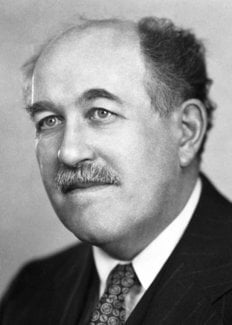Otto Stern
Biographical

Otto Stern was born in Sorau, Upper Silesia, Germany, on February 17, 1888. In 1892 he moved with his parents to Breslau, where he attended high school. He began to study physical chemistry in 1906, receiving his Ph.D. degree from the University of Breslau in 1912. In the same year he joined Einstein at the University of Prague and later followed him to the University of Zurich, where he became Privatdocent of Physical Chemistry at the Eidgenössische Technische Hochschule in 1913.
In 1914 he went to the University of Frankfurt am Main as Privatdocent of Theoretical Physics, remaining there until 1921, except for a period of military service. From 1921 to 1922 he was Associate Professor of Theoretical Physics at the University of Rostock, becoming, in 1923, Professor of Physical Chemistry and Director of the laboratory at the University of Hamburg, where he remained until 1933. In that year he moved to the United States, being appointed Research Professor of Physics at the Carnegie Institute of Technology, Pittsburgh where he remained until 1945, then becoming professor emeritus.
His earliest work was in the field of theoretical physics, especially that of statistical thermodynamics and quantum theory, on which he has published important papers. After 1919, his attention was directed more to experimental physics. His development and application of the molecular beam method proved to be a powerful tool for investigating the properties of molecules, atoms and atomic nuclei. One of the early applications of this was the experimental verification of Maxwell’s law of velocity distribution in gases. He collaborated with Gerlach to work on the deflection of atoms by the action of magnetic fields on their magnetic moment, then went on to measure the magnetic moments of sub-atomic particles, including the proton. His work on the production of interference by rays of hydrogen and helium was a striking demonstration of the wave nature of atoms and molecules.
Dr. Stern was awarded an LL.D. by the University of California, Berkeley, 1930. He is a member of the National Academy of Sciences (USA), the American Association for the Advancement of Science, and the Philosophical Society. He holds foreign membership of the Royal Danish Academy of Sciences. He lives at Berkeley, California.
This autobiography/biography was written at the time of the award and first published in the book series Les Prix Nobel. It was later edited and republished in Nobel Lectures. To cite this document, always state the source as shown above.
Otto Stern died on August 17, 1969.
Nobel Prizes and laureates
Six prizes were awarded for achievements that have conferred the greatest benefit to humankind. The 14 laureates' work and discoveries range from quantum tunnelling to promoting democratic rights.
See them all presented here.
